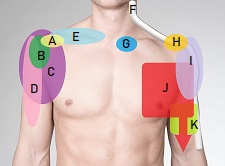- Home
- Diagnosis Guide
- Referred Shoulder Pain
Pain From Shoulder To Hand
Written By: Chloe Wilson BSc (Hons) Physiotherapy
Reviewed By: SPE Medical Review Board
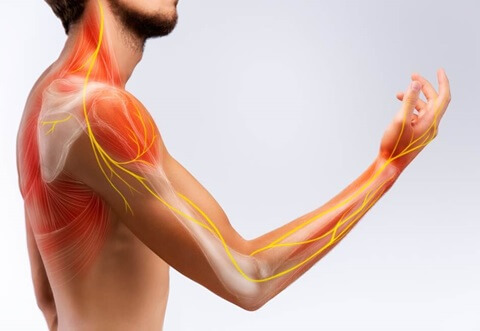
Pain from the shoulder to the hand is a common problem, often known as referred or radiating pain.
Shoulder pain radiating down the arm may come from a problem in the shoulder itself, but is often actually due to a problem in the neck, even if you don’t have any neck symptoms.
Referred shoulder pain is often accompanied by other symptoms such as tingling, numbness, weakness or stiffness, and it’s often the associated symptoms that help us work out what is wrong. There may be anything from a dull ache to sharp, shooting pain or a gnawing toothache to a burning sensation.
Common Causes Of Pain From Shoulder To Hand
Let’s start by looking at the most common causes of pain from the shoulder to the hand, firstly concentrating on those caused by neck problems and nerve damage, and then moving on to problems from the shoulder itself.
1. Neck Problems & Nerve Damage
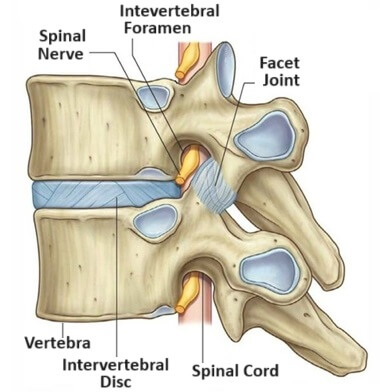
The most common cause of pain from the shoulder to the hand is nerve pain that actually comes from a problem in the neck aka cervical spine.
There are lots of different names for pain like this including cervical radiculopathy, nerve root compression and referred pain.
Nerves arise from the cervical spine region (neck bones) where they branch out from the spinal cord (at the nerve root) and extend across the shoulder and down the arm to the hand.
Essentially, if something pinches, squashes or irritates one of the upper limb nerves, then it can result in tingling, numbness, weakness and shoulder pain radiating down the arm.
This pain might only be felt around the site where the compression or irritation is, but more often than not, it also sends pain signals further down the path of the nerve. This results in pain from the shoulder to the wrist or hand.
The most common things that cause nerve damage and shoulder pain radiating down the arm that come from a neck problem, aka nerve root compression, are:
- Disc Problems: spinal discs sit between the neck bones to provide cushioning and space between the vertebra. There may be a disc bulge, herniation or degeneration, any of which places increased pressure or irritation on the neighbouring nerve which causes pain from shoulder to hand. Common features of pain from disc problems are that the pain gets worse when you cough or sneeze due to increased pressure on the discs. Find Out More >
- Spinal Stenosis: is where there is narrowing of one or more of the bony openings in the neck that the nerves pass through. This loss of space can place pressure on the nerve resulting in pain from shoulder to wrist. There are a few different causes of spinal stenosis including cervical arthritis, ankylosing spondylitis and spinal fractures. Find Out More >
Nerve problems are the most common cause of pain from shoulder to hand. There may or may not be some pain or stiffness in the neck, and the symptoms may only travel part way down the arm or extend all the way to the fingers. The tell-tale signs of the pain being neural (from a nerve) are that there is a burning or sharp shoulder pain going down the arm rather than a dull ache, and there is associated tingling, numbness and in some case weakness.
Nerve pain only travels down the nerve, not up it, so any symptoms of nerve damage will only be felt at the site of the problem or further down the arm, not above it. But remember, there may be no pain at the compression/irritation site – it is very common for shoulder or arm pain to be referred pain from the neck without any obvious neck symptoms.
You can find out loads more about how nerve problems cause pain from shoulder to hand, including causes, symptoms, diagnosis and treatment options in the Arm Nerve Pain section.
2. Brachial Neuritis
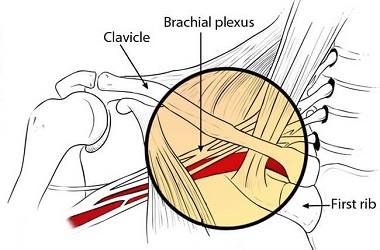
Another possible cause of pain from the shoulder to the hand is brachial neuritis.
Brachial neuritis is a condition where there is inflammation of the brachial plexus, a network of intertwined nerves that runs from the neck along the top of the shoulder.
Symptoms of brachial neuritis usually develop very suddenly and rapidly, often at night. There is usually intense sharp, stabbing or burning pain in the neck which may radiate out causing pain from shoulder to hand. Pain from brachial neuritis usually only affects one arm and typically gets worse with any arm movement. Over time (days or weeks), the shoulder pain going down the arm may start to subside with numbness, muscle weakness and paralysis becoming more apparent instead.
Brachial neuritis is notoriously difficult to diagnose and often nerve conduction studies or electromyography is used to determine the extent of the nerve damage. Treatment usually involves a combination of rest, medication, physical therapy and in some case surgery.
You can find out all about the causes, symptoms, diagnosis and treatment options in the Brachial Neuritis section.
3. Fibromyalgia
Fibromyalgia can cause radiating pain from the shoulder to the hand, often affecting both arms.
Fibromyalgia is a chronic condition characterized by widespread musculoskeletal pain, fatigue, sleep disturbances, hypersensitivity, joint stiffness and cognitive issues. While fibromyalgia primarily affects the muscles and soft tissues, it can also cause symptoms such as pain, tingling, or numbness that radiate from the shoulders to the hands or other parts of the body. This is often referred to as "fibromyalgia-related myofascial pain" or "fibromyalgia-related neuropathic pain."
The exact cause of fibromyalgia is unknown, but it is believed to involve abnormalities in pain processing in the central nervous system. Treatment for fibromyalgia typically involves a combination of medication, physical therapy, exercise, stress management techniques, and lifestyle modifications to help manage symptoms and improve quality of life.
If you are experiencing pain from your shoulders to your hands, especially if you have other symptoms consistent with fibromyalgia, it's important to consult with a healthcare professional for proper evaluation and management.
4. Thoracic Outlet Syndrome
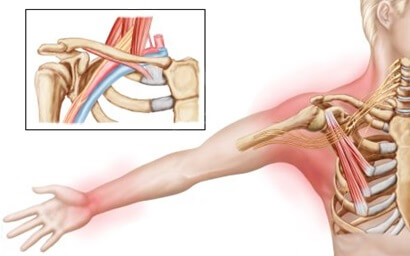
Thoracic outlet syndrome (TOS) can cause pain from the shoulder to the hand, along with numbness, tingling, coldness, paleness, heaviness and weakness.
Symptoms of thoracic outlet syndrome typically get worse when you raise your arm.
Thoracic outlet syndrome occurs when the nerves or blood vessels become compressed in the thoracic outlet region, the area between your neck and shoulder.
There are three classifications for thoracic outlet syndrome depending on which structures are compressed:
- Neurogenic TOS: occurs when the brachial plexus, a network of nerves originating from the spinal cord in the neck that supply the shoulder, arm, and hand, becomes compressed. Symptoms typically include numbness, tingling, weakness and pain from shoulder to hand, often exacerbated by overhead activities or holding the arm outstretched. This is the most common type of thoracic outlet syndrome.
- Venous TOS: occurs when the subclavian vein, which carries blood from the arm back to the heart, becomes compressed. Symptoms may include swelling, heaviness, or discoloration of the arm or hand, as well as discomfort and pain from shoulder to wrist, usually in the dominant arm.
- Arterial TOS: occurs when the subclavian artery, which carries blood to the arm and hand, becomes compressed underneath the collarbone. It often results in blood clot formation. Symptoms may include coldness, paleness, or weakness in the arm or hand, as well as pain or numbness down the arm. This is the rarest type of thoracic outlet syndrome, accounting for approximately 1% of cases.
Common causes of thoracic outlet syndrome include anatomical abnormalities (e.g. an extra cervical rib), trauma (e.g. car accident or repetitive strain injury), poor posture, or muscular hypertrophy (enlargement) of the muscles surrounding the thoracic outlet.
Treatment for thoracic outlet syndrome depends on the underlying cause and severity of symptoms but usually includes physical therapy, exercises to improve posture and muscle strength, pain management techniques, or, in severe cases, surgery to relieve compression of the affected nerves or blood vessels and the associated pain from shoulder to hand.
5. Heart Problems
Heart problems can sometimes cause referred chest and shoulder pain radiating down the arm to the hand, most typically down the left arm, although it can occur on the right side too.
This is known as referred pain or angina pectoris, and it can be a symptom of conditions such as coronary artery disease, heart attack, or angina. The pain may be described as aching, squeezing, pressure, or tightness, and it may be accompanied by other symptoms such as shortness of breath, nausea, sweating, or dizziness.
If you experience chest pain or pain radiating to the shoulder or arm, especially if it is accompanied by other concerning symptoms, it's important to seek prompt medical attention to rule out serious heart-related conditions.
Shoulder Problems Causing Pain From Shoulder To Wrist
There are a number of shoulder conditions that can cause referred pain from the shoulder to the hand. The key sign that the problem originates in the shoulder rather than the neck is that there are no neurological signs i.e. no tingling or numbness in the arm.
1. Shoulder Impingement
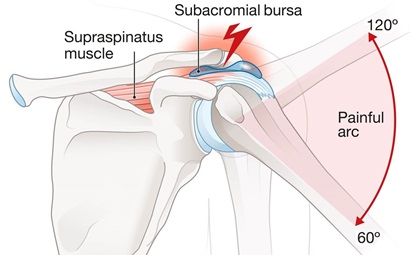
The most common shoulder problem that can refer pain down the arm to the elbow or hand is shoulder impingement.
Shoulder impingement syndrome occurs when the tendons of the rotator cuff muscles become squashed, irritated and inflamed as they pass through the narrow space between the top of the upper arm bone (humerus) and the acromion, a bony projection of the shoulder blade (scapula).
This can lead to pain, weakness, and limited range of motion in the shoulder, which may radiate down the arm to the hand.
Impingement syndrome is particularly common in people who do lots of overhead activities e.g. racket sports or DIY, and people over the age of 50.
Common symptoms of impingement syndrome are a sharp or toothache type pain in the outer shoulder that is worse when reaching up above your head or behind your back. A classic feature of impingement syndrome is a painful arc as you lift your arm. The pain may be isolated to the shoulder but as the condition progresses you may get pain from shoulder to elbow and in some cases all the way down the arm to your hand.
You can find out more about pain from your shoulder to hand and the causes, symptoms and best treatment options in the Shoulder Impingement Syndrome section.
2. Trigger Points
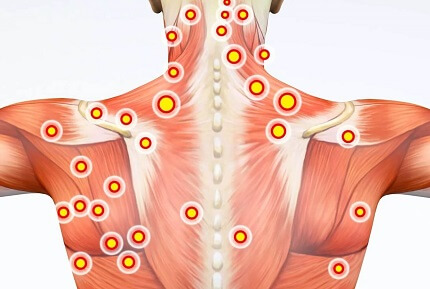
Another possible cause of pain from shoulder to hand are myofascial trigger points, aka knots or acupressure points.
Trigger points are hyperirritable spots within a muscle that can cause local or referred pain, as well as other symptoms such as stiffness, weakness, or restricted range of motion.
Trigger points can occur in any muscle but when they develop in the muscles of the shoulder region, they can potentially cause radiating pain from shoulder to hand.
Trigger points often develop in muscles that are overworked, strained or subject to repetitive stress. They typically have specific referral patterns, meaning that the pain they produce can be felt in predictable locations away from the actual site of the trigger point. For example, trigger points in the trapezius muscle or the rotator cuff muscles may cause referred pain from shoulder to hand. In some cases, trigger points can irritate nearby nerves, leading to increased sensitivity and altered pain perception, increasing the risk of referred pain.
Trigger points usually respond well to physical therapy including manual techniques e.g. massage or myofascial release, acupuncture, stretching and strengthening exercises and posture correction.
If your pain from shoulder to hand is accompanied by one or more lumps in the muscles around your shoulder find out more in the Trapezius Pain And Trigger Points section.
3. Frozen Shoulder
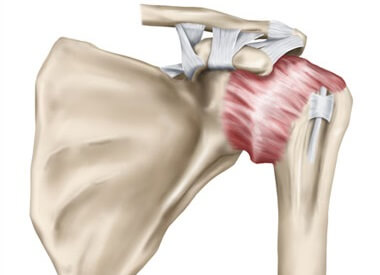
Frozen shoulder, aka adhesive capsulitis, is a condition characterized by pain, stiffness, and limited range of motion in the shoulder joint.
While frozen shoulder typically affects only the shoulder joint, the pain can sometimes radiate down the arm to the hand due to altered movement patterns or compensatory movements.
Frozen shoulder is caused by inflammation and thickening of the capsule surrounding the shoulder joint, leading to adhesions or scar tissue that restricts movement. Risk factors include age (typically 40-60 years old), gender (more common in women), shoulder injuries or surgery and medical conditions (e.g. diabetes or thyroid problems).
The hallmark symptom of frozen shoulder is stiffness that gradually worsens over time, limiting arm movements, sometimes quite severely. Frozen shoulder pain may be dull, aching, or sharp and is often felt deep within the shoulder joint. As the condition progresses, the stiffness can limit the ability to move the shoulder in all directions, including lifting the arm overhead, reaching behind the back, or rotating the arm outward or inward.
If your pain from shoulder to hand is accompanied by increasingly restricted shoulder and arm movement, find out more about the causes, symptoms and treatment options for Frozen Shoulder.
4. Shoulder Fractures
Shoulder fractures can also cause pain that radiates from the shoulder to the hand, especially if there is associated nerve or blood vessel injury.
The main area of pain is usually felt around the fracture site but you can get pain from shoulder to hand if there is significant swelling, displacement or angulation of the fracture fragments that affect the surrounding soft tissues, nerves or blood vessels.
Shoulder fractures that can cause pain from shoulder to hand include:
- Clavicle Fractures: break in the collarbone, the bone that connects the shoulder to the chest. There are a number of blood vessels and nerves that run directly under the clavicle so fractures here can cause referred pain from shoulder to hand with tingling and numbness. Find Out More >
- Proximal Humerus Fractures: a break in the upper part of the upper arm bone (humerus) that forms the ball part of the shoulder joint. The axillary nerve, in particular can be injured in proximal humerus fractures leading to pain from shoulder to hand with weakness or numbness. Find Out More >
- Humeral Shaft Fractures: a break anywhere in the middle section of the upper arm bone which may cause associated damage to the surrounding nerves or blood vessels. Find Out More >
- Scapula Fractures: a break in the shoulder blade bone. Scapula fractures are rare as the bone is extremely strong and well protected so it takes a significant force to break the scapula. As a result, there are often other associated injuries such as broken ribs and nerve and blood vessel damage which cause pain from shoulder to hand. Find Out More >
Shoulder fractures are normally caused by trauma such as a fall or road traffic accident. There is usually immediate pain and swelling and arm movements may well be restricted.
You can find out more about the different types of fractures and how to treat them in the Shoulder Fractures section.
Shoulder Pain That Doesn’t Refer Below The Elbow
It doesn’t just help to know what can cause pain from the shoulder to the hand, it can also help to know what doesn’t!
- Rotator Cuff Tear: damage to one of the four rotator cuff muscles that surround the shoulder joint. Tears can occur suddenly with an injury, or more frequently from repetitive friction and wear and tear. Rotator cuff tears may result in weakness and clicking in the shoulder with a dull ache, deep inside the shoulder that gets worse with lifting and twisting shoulder movements. There may be pain from shoulder to elbow, but rotator cuff tears don’t typically refer pain below the elbow. Find Out More >
- Shoulder Tendonitis: inflammation or degeneration of one of the shoulder tendons. It is usually caused by repetitive overhead activities or heavy lifting, bone spurs, aging or instability. Shoulder tendonitis can cause shoulder and upper arm pain but generally the pain does not extend below the elbow. Find Out More >
- Shoulder Bursitis: inflammation of one of the fluid filled sacs that sit between bones, tendons and muscles. Bursitis pain usually develops gradually and tends to be a background aching pain with occasional sharp pain if the bursa gets squashed. Bursitis pain is usually fairly localised but there may be pain in shoulder and arm down to the elbow. Find Out More >
- Anything Below The Shoulder: Pain usually only refers downwards, typically down the path of the nerves so conditions that originate below the shoulder e.g. tennis elbow or carpal tunnel syndrome won’t usually cause shoulder or upper arm pain
Differential Diagnosis
When diagnosing the underlying cause of pain from the shoulder to the hand, remember:
Neck shoulder and arm pain is usually caused by a problem in the neck that is affecting the nerves from the cervical spine, typically cervical radiculopathy or occasionally brachial neuritis
Tingling, numbness or weakness with pain from shoulder to hand is usually a neural problem
Pain from shoulder to hand with paleness or coolness in the arm is usually a vascular problem such as thoracic outlet syndrome
A shoulder lump with associated shoulder pain radiating down arm is often due to trigger points or shoulder fractures
Shoulder pain going down the arm that is associated with increasingly restricted shoulder movements is usually due to a frozen shoulder or shoulder fracture
Pain from shoulder to hand affecting both arms and with widespread body pain, fatigue and hypersensitivity is usually a sign of fibromyalgia
Chest and shoulder pain going down the arm may be a sign of a heart problem and should be checked out immediately
Sudden pain from shoulder to wrist may be from shoulder fractures, brachial neuritis or a heart attack – if it is accompanied by pressure or pain in your chest, shortness of breath, sweating or dizziness, seek urgent medical attention immediately.
If you get a painful arc of shoulder pain going down arm when raising your arm i.e. pain when the arm is lifted between 70-120 degrees but no pain at the start or end of the movement, it’s likely you have shoulder impingement syndrome
Pain From Shoulder To Hand Summary
Shoulder pain going down the arm is a common problem which may extend all the way into the hand.
If it is associated with tingling, numbness, weakness or shooting pain from shoulder to hand, it is most likely a nerve problem.
In most cases, only one arm is affected, but you may get bilateral shoulder pain radiating down the arm with fibromyalgia.
Often, shoulder pain going down the arm is actually from a neck problem, even if there is no obvious pain in the neck itself – pain can travel down the nerve but not back up it.
While many shoulder problems can refer pain down the arm, usually the pain stops at the elbow, the main exceptions being impingement syndrome, frozen shoulder, trigger points and shoulder fractures.
You may also be interested in the following articles
- Shoulder Lumps And Bumps
- Burning Shoulder Pain
- Front Shoulder Pain
- Shoulder Pain At Night
- Upper Arm Pain
Related Articles
Page Last Updated: May 9th, 2024
Next Review Due: May 9th, 2026

